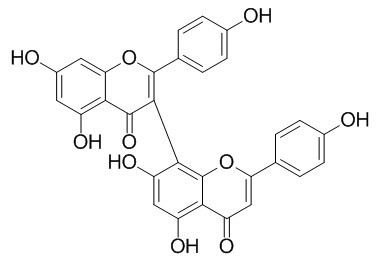3,8'-Biapigenin
3, 8''-Biapigenin can modulate intracellular ROS production.
Inquire / Order:
manager@chemfaces.com
Technical Inquiries:
service@chemfaces.com
Tel:
+86-27-84237783
Fax:
+86-27-84254680
Address:
1 Building, No. 83, CheCheng Rd., Wuhan Economic and Technological Development Zone, Wuhan, Hubei 430056, PRC
Providing storage is as stated on the product vial and the vial is kept tightly sealed, the product can be stored for up to
24 months(2-8C).
Wherever possible, you should prepare and use solutions on the same day. However, if you need to make up stock solutions in advance, we recommend that you store the solution as aliquots in tightly sealed vials at -20C. Generally, these will be useable for up to two weeks. Before use, and prior to opening the vial we recommend that you allow your product to equilibrate to room temperature for at least 1 hour.
Need more advice on solubility, usage and handling? Please email to: service@chemfaces.com
The packaging of the product may have turned upside down during transportation, resulting in the natural compounds adhering to the neck or cap of the vial. take the vial out of its packaging and gently shake to let the compounds fall to the bottom of the vial. for liquid products, centrifuge at 200-500 RPM to gather the liquid at the bottom of the vial. try to avoid loss or contamination during handling.
J. Pharm. Biomed. Anal.2024, 245:116193.
Front Plant Sci.2023, 14:1207940.
Mol Neurobiol.2021, 58(8):3665-3676.
Research on Crops.2017, 18(3):569
Patanjali Research Foundation2024, ssrn.4807357
J Biomed Sci.2020, 27(1):60.
J Sci Food Agric.2022, 102(4):1628-1639
Evid Based Complement Alternat Med.2017, 2017:7383104
Pharmaceuticals (Basel).2020, 13(9):262.
RSC Advances2017, 86
Related and Featured Products
Phytochemistry. 2009 Jan;70(2):244-9.
Cellular reactive oxygen species inhibitory constituents of Hypericum thasium Griseb.[Pubmed:
19203769 ]
METHODS AND RESULTS:
The phytochemical investigation of the ethyl acetate extract of Hypericum thasium has led to the characterization of four benzophenone derivatives 1-4, a known benzophenone 5 and four known flavonoids, quercetin (6), quercitrin (7), isoquercetin (8), and 3,8'-Biapigenin (9). Lucigenin- and luminal-based chemiluminescence assays were employed to monitor the inhibitory activity of these compounds towards the production of reactive oxygen species (ROS) by human polymorphoneutrophils (PMNs).
CONCLUSIONS:
The assay results showed that benzophenones 1 and 3 are extracellular inhibitors of ROS production, while flavonoids 6, 8, and 9 can modulate intracellular ROS production.



